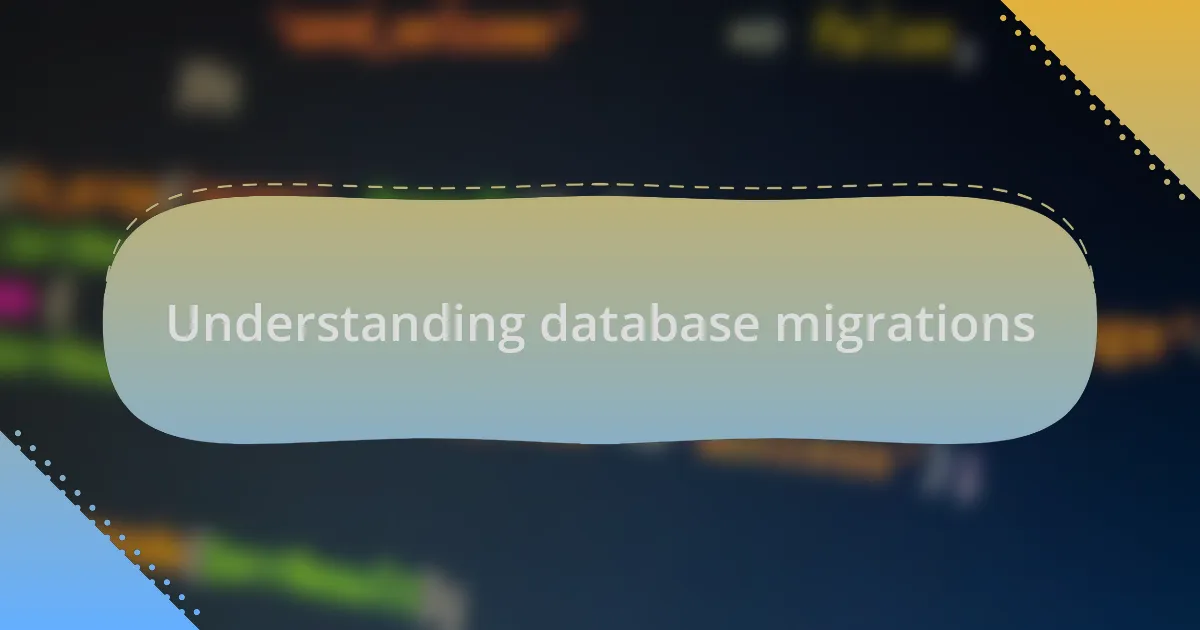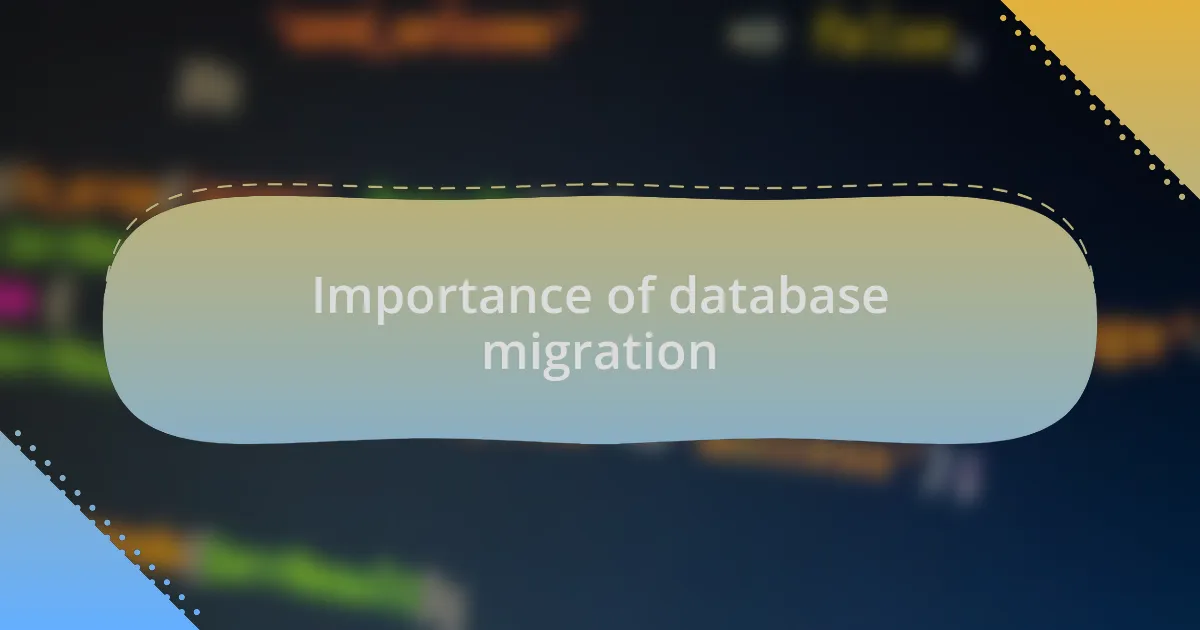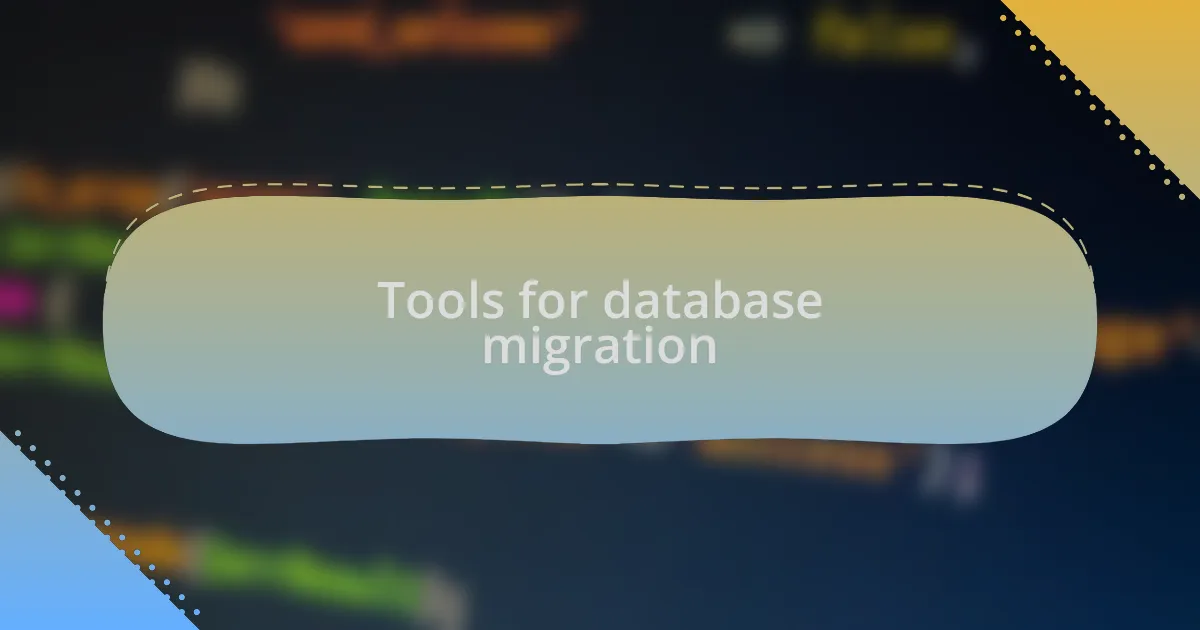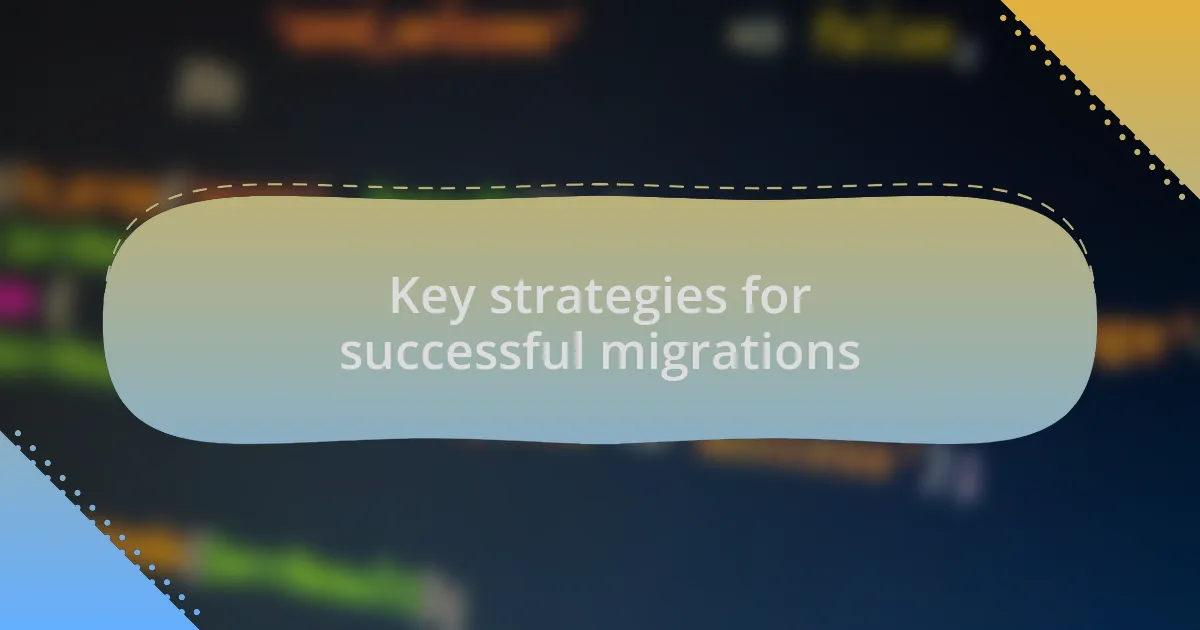Key takeaways:
- Database migrations are crucial for maintaining database integrity and enabling future growth, requiring careful planning and execution.
- Common challenges include data integrity issues and minimizing downtime, which can be mitigated by thorough testing and phased approaches.
- Utilizing the right tools, such as Flyway and Liquibase, can streamline the migration process and reduce anxiety during transitions.
- Key strategies for successful migrations include building a comprehensive plan, involving stakeholders early, and rigorously testing in a staging environment.

Understanding database migrations
Database migrations can seem daunting at first, but my experience has shown me they are essential for maintaining the integrity and structure of a database. During a recent project, I faced a critical situation when a new feature required modifying several tables. The fear of data loss was real, but understanding the migration process—backing up the database beforehand and testing on a staging environment—transformed my anxiety into confidence.
It’s fascinating to consider how often we overlook the underlying structure of our applications. Building a feature without thinking through the database changes required can lead to serious issues down the road. I remember a time when a mismanaged migration caused unexpected application downtime; that taught me the hard way that each change needs careful planning and execution.
When I think about database migrations, I often ask myself: how can I make this process as seamless as possible? What I’ve found is that employing a systematic approach, using tools like migration frameworks, helps streamline the transitions. Each migration becomes a little less intimidating, making the overall development process smoother and more adaptable to change.

Importance of database migration
The significance of database migration cannot be overstated. I recall when I updated a legacy system, and the thought of migrating old data felt overwhelming. However, that migration turned out to be a pivotal moment for the project, enhancing performance and stability in ways I hadn’t anticipated.
It’s easy to think of migration as just a technical requirement, but it’s really about enabling flexibility for future growth. I once worked on a project where database migrations unlocked a pathway to implement a significant new feature. That moment reinforced my belief that migrations are not just about moving data; they are essential for evolving and improving an application.
Have you ever experienced a project stagnating due to an inflexible database? I certainly have. By successfully managing migrations, I’ve witnessed firsthand how a well-structured approach can prevent bottlenecks. The excitement that comes from resolving these challenges energizes me; it’s a reminder that thoughtful migrations open doors to innovation.

Common challenges in database migration
One of the main hurdles I faced during a database migration was dealing with data integrity issues. Imagine painstakingly transferring gigabytes of data only to discover missing or corrupted records. It’s a gut-wrenching experience that can send you back to square one, questioning every step of your process. I learned that conducting thorough pre-migration tests and employing validation checks could save me from this heartache.
Another challenge that often reared its head was downtime. I can’t stress enough how critical it is to minimize downtime for users. During one migration, I implemented a phased approach where I moved smaller chunks of data gradually, which let users continue to access the system without interruption. This method not only kept the users happy but also allowed me to troubleshoot issues in real-time, making the process far less stressful.
Then there’s the technical debt. It’s like an invisible weight you carry into a migration. I once dove into a migration without fully addressing outdated schemas, and it created a domino effect of problems post-migration. Having a clear plan and documentation can be your lifeline here. Does anything resonate with your experiences? Trust me, seeking clarity ahead of time pays off tremendously.

Tools for database migration
When it comes to tools for database migration, I’ve found that choosing the right one can make a world of difference. For instance, I turned to tools like Flyway for its version control feature, which allowed me to manage migrations as part of my codebase. This gave me a sense of confidence, knowing that I could track changes precisely and revert if necessary.
I also experimented with AWS Database Migration Service, and what struck me was the ease of setup. The first time I used it, I felt a wave of relief wash over me—it facilitated the migration with minimal downtime, so I didn’t have to hold my breath while my users awaited the switch. Have you ever experienced that anxiety during a migration? Using the right tool can ease that burden significantly.
Another tool worth mentioning is Liquibase, which offers an XML-based approach. I was initially wary of this method, thinking it would complicate things further, but it turned out to be incredibly intuitive. It allowed me to write database changes in a script-like format, which not only standardized the process but also made collaboration with my team a breeze. If you’re venturing into database migrations, consider what tools align best with your workflow. Do they enhance your efficiency or add to your stress?

My personal experience with migrations
When I first tackled database migrations, I underestimated the planning required. I remember one particular migration where I thought it would be a simple task. Instead, I found myself wrestling with unexpected issues, like data inconsistencies. This experience taught me that adequate preparation is crucial. Do you ever feel overwhelmed when faced with potentially messy data during migrations?
One migration experience stands out vividly to me. I had a tight deadline and decided to go with a more automated approach. The night before the launch, I had a panic moment as I realized some migrations hadn’t run as expected. That adrenaline rush pushed me to dig deeper; I learned to review logs thoroughly and implement checkpoints. It’s funny how those high-pressure moments can lead to valuable learning, isn’t it?
I also fondly recall a migration that went surprisingly smooth, thanks to the collaborative efforts of my team. We were all hands-on deck, and I’ll never forget the sense of accomplishment we shared once everything was in place. It felt like we had not only migrated data but had also cultivated a stronger bond through teamwork. Have you ever experienced that surge of triumph after overcoming what seemed like insurmountable obstacles?

Key strategies for successful migrations
One of the most effective strategies I’ve learned is to build a comprehensive migration plan beforehand. I recall a migration where I created a detailed checklist that mapped out each step, from data extraction to validation. This allowed me to stay organized and minimize oversights, which I learned is vital for keeping the process on track. Have you ever felt the relief of having a clear plan in front of you?
Another critical tactic is involving all stakeholders early in the process. In one project, I invited a team member from the operations side, and it turned out that their insights on data usage significantly shaped our approach. Their perspective helped me anticipate potential issues, making the migration easier and more efficient. Isn’t it amazing how diverse input can enhance the workflow?
Lastly, I can’t stress enough the importance of rigorously testing your migrations in a staging environment before going live. A daunting experience taught me this lesson—one time, I assumed everything would be fine without a thorough test, and the aftermath was a nightmare. I learned to embrace testing as a necessity, which ultimately saved me time and stress. Have you noticed how that initial investment in testing really pays off in the end?

Lessons learned from my migrations
One major lesson I learned during database migrations is the significance of monitoring the progress closely. I remember a particular instance where I became so engrossed in the steps that I neglected to check on the migration in real time. By the time I realized there were issues, significant delays had occurred. It was a stark reminder that staying vigilant can prevent minor problems from blossoming into major setbacks. Have you ever been caught off guard like that?
Another insight that sticks with me is the value of clear communication among the team. I once worked on a project where miscommunication about the schema changes led to confusion during the migration. It created unnecessary stress and could have been avoided with regular updates. This experience taught me that keeping the lines of communication open among team members is fundamental to a successful migration. Wouldn’t you agree that a well-informed team works more harmoniously?
Lastly, I’ve come to appreciate the role of documenting the migration process thoroughly. I used to think it was excessive, but after a complex migration that required revisiting decisions, I realized how vital those records are. They become invaluable references for future migrations and offer insights into what worked and what didn’t. Isn’t it astonishing how a bit of documentation can save you from revisiting the same pitfalls?